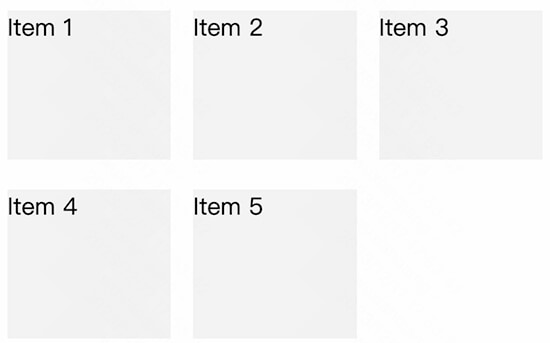如果你有一个列表,希望在页面上一行展示三个元素,可以使用 CSS 中的弹性布局(flexbox)来实现。6 r- _+ q7 p+ W: E! V3 I' q2 z
 ; B0 f9 G, a# U* M" C* n
; B0 f9 G, a# U* M" C* n
HTML 结构:$ Q8 p# d3 Y; N4 N- E! `
<div class="container">
<div class="list-item">Item 1</div>
<div class="list-item">Item 2</div>
<div class="list-item">Item 3</div>
<div class="list-item">Item 4</div>
<div class="list-item">Item 5</div>
<!-- 其他列表项 -->
</div>
CSS 样式:
: P* L. h. n3 e% l' D.container {
display: flex;
flex-wrap: wrap;
}
.list-item {
flex: 0 0 33.33%;
/* 或者使用 flex-basis 属性
flex-basis: 33.33%;
*/
/* 其他样式属性,例如边距、填充等 */
}
在上面的示例中,我们创建了一个包含列表项的容器 <div class="container">,并为每个列表项添加了类名 <div class="list-item">。通过设置容器的显示属性为 flex,并使用 flex-wrap: wrap 来使得列表项可以换行。通过设置列表项的 flex 属性为 0 0 33.33%,或者使用 flex-basis: 33.33%,我们将宽度平均分配给每个列表项,使其一行显示三个。* e0 t5 b: q$ Q' h0 y
你可以根据实际情况调整容器和列表项的样式,例如添加边距、填充等。如果列表项的数量超过三个,超出的列表项会自动换行到下一行。
k5 ~" F' s- t如果只有中间的一个元素需要左右间隙,而页面的左边和右边不需要间隙,你可以使用 CSS 的 margin 属性来实现。下面是相应的代码示例:! h: l5 n7 q+ h2 ~5 a
HTML 结构:<div class="container">
<div class="list-item">Item 1</div>
<div class="list-item with-margin">Item 2</div>
<div class="list-item">Item 3</div>
<div class="list-item">Item 4</div>
<div class="list-item with-margin">Item 5</div>
<!-- 其他列表项 -->
</div>
CSS 样式:4 m+ }- L, w$ Y/ n, H% D
.container {
display: flex;
flex-wrap: wrap;
}
.list-item {
flex: 0 0 calc(33.33% - 10px); /* 考虑到间隙,减去 10px */
margin-top: 5px; /* 上方间隙为 5px */
margin-bottom: 5px; /* 下方间隙为 5px */
/* 其他样式属性,例如背景颜色、文字样式等 */
}
.with-margin {
margin-left: 15px; /* 左边间隙为 15px */
margin-right: 15px; /* 右边间隙为1 5px */
}
在上面的示例中,我们为中间的元素添加了一个额外的类名 .with-margin,并使用该类名来设置左右间隙。
7 O/ a9 J/ H" y# i& m+ Q0 M我们使用 calc() 函数来计算每个列表项的宽度,考虑到间隙,我们将宽度设置为 33.33% - 10px。每个元素减去 10px 那么一行的就预留出了 30px 的间隙。对于具有 .with-margin 类名的元素,我们使用 margin-left 和 margin-right 属性为其添加左右各 15px 的间隙。
y/ }1 r, l g1 V* n. n1 O) p这样,只有中间的一个元素会有左右间隙,而页面的左边和右边则没有间隙。 |  |手机版|小黑屋|paopaomj.COM
(
|手机版|小黑屋|paopaomj.COM
( ![]() 渝ICP备18007172号|
渝ICP备18007172号|![]() 渝公网安备50010502503914号 )
渝公网安备50010502503914号 )